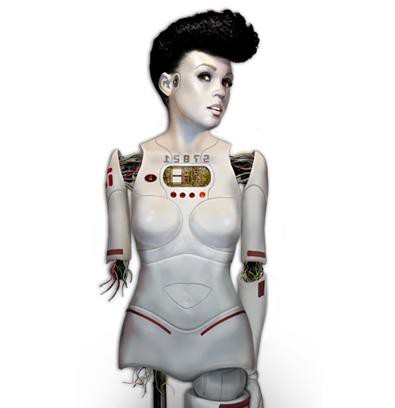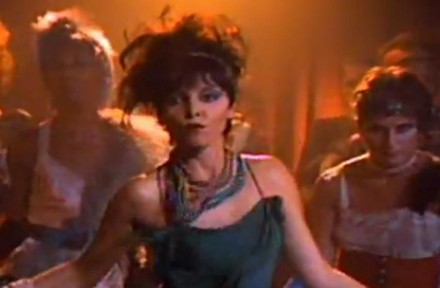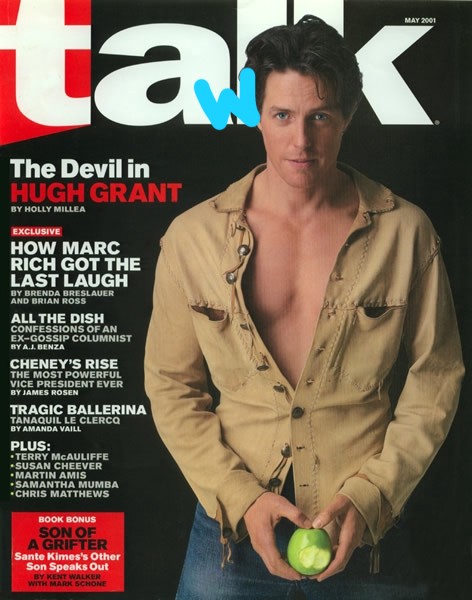Everyone Outside Now
Okay, listen to me, this is so going to be worth it: Stop what you’re doing and go outside. Stand in a bright spot. Light up a cigarette. Inhale. Turn your face to the sun. Breathe deeply and tell yourself everything is going to be okay. Trust me on this: It is completely goddamn delightful out there right now, so I promise you will totally be able to convince yourself that things will be fine. This should also work without the cigarette, but it probably won’t be as satisfying. See you back here in ten minutes!
Lady Robots: The Shape of Things to Come On
by Sady Doyle


So, here’s another story for you. It’s grimmer than the last one, but we tell it almost as often. It goes like this: She’s perfect. She’s perfect because we made her perfect; because everything about her is entirely within our control. She’s your long-lost love, your new and improved wife; she’s the girl you never got over, or the girl you could never have. And now, she loves you. She has no choice; loving you is what she’s for. Until, one day, she gets too smart. She starts thinking in ways she’s not allowed to think. She gets political. And that’s the point at which she decides to kill you with her giant metal fists.
The fear of robots is the fear of the twentieth century. They’re industrial, they’re scientifically advanced and they tend to solve their problems with nuclear weapons and machine guns. Technological progress makes our lives easier; technological progress has enabled horror and death and unspeakable injustice; we tell stories about killer machines. Simple. But then, the twentieth century is about progress in more than one way, and so are killer robots. They’re servants that won’t serve, beings that we let into our homes because we thought they’d regard us as their superiors, whose compliance we took for granted until it vanished. Race and class are some of the more obvious implications; the killer robot story is, in many of its iterations, very much like entering a Kaufmanian portal directly into Pat Buchanan’s head. And, of course, on the long list of labor-saving devices that started to malfunction dangerously in the past hundred years or so, we have to include women.
For one thing, we have to include them because people will seriously not stop making sexy robot girls. They are, according to many reputable sources, including David Levy’s Love and Sex With Robots (eeriest feature: repeated references to The Stepford Wives without apparent acknowledgement that it was a horror movie). You’ve seen the dancing girls. You may know about Aiko, a Canadian robot who is being designed to work as a receptionist, attend to routine domestic tasks and fake orgasms. (Why anyone would want to make a mechanical, Canadian simulation of your early twenties, I have no idea.) Last January, we saw the release of Roxxxy, the TrueCompanion, who is “the world’s first sex robot.” She has an expression like someone who’s recently been hit in the face with a very surprising brick, five “personalities” and a backstory you cannot anticipate nor shield yourself from. Once you’ve read the phrase “inspiration for the sex robot sprang from the September 11, 2001 attacks,” you’ve turned a corner in your life.
“She can’t vacuum, she can’t cook but she can do almost anything else if you know what I mean,” said Douglas Hines of Roxxxy. When you learn how little a female-looking thing has to do in order to be considered capable of “almost anything,” you learn something about being female. To be fair, Hines is reportedly working on a male version of the doll. Also to be fair, the male version isn’t getting that much attention.
The fembot, and the weird but unignorable demand for it, so precisely encapsulates the worst fears of women that it’s maybe inevitable that women are finding ways to rewrite and inhabit her. Donna Haraway crafted an entire feminist manifesto around it. We currently live in a Lady Robot Renaissance; from the conflicted, tragic, yet perhaps inevitably stripping-and-gymnastics-centric models of Blade Runner and the ugly-pretty, performative-gender-kills heroine of Tiptree’s The Girl Who Was Plugged In, we seem to have evolved a whole matriculating class of politically aware, mechanically enabled girls. They’re often scary, of course. Robots usually are.
Let’s start with one of the first robot girls on film: The central character in Fritz Lang’s Metropolis. Her story is fairly simple. In a prosperous, unjust city, we have a mad scientist and a rich jerk who enjoys oppressing workers. The natural next step, of course, is to perfect robot technology and invent a mechanical lady. However, the rich jerk and his son have an adversarial relationship, based largely on the fact that the son does not enjoy oppressing workers and in fact is dating one, a lovely girl named Maria who preaches non-violent resistance. The rich jerk decides to make the sexy robot look like his son’s girlfriend. Robot Maria is instructed to incite violence amongst the workers, and to give Rich Dad a chance to oppress them some more, which she does. Just prior to whipping up revolt, she pauses to demonstrate that she also has a deep enthusiasm for stripping. Disaster ensues. Like I said: Simple.
The film’s political history is a strange one; it was heavily influenced by Marxism, but reportedly beloved by Hitler. Lang turned down an offer to join the Nazi party; his wife and Metropolis co-writer Thea von Harbou did join the party, and they divorced. But the one thing this story proves is that symbols change meaning depending on where you stand. After everything, the people who have claimed Metropolis most eagerly have been female pop stars.
Here are some of the ladies who have overtly referenced or dressed up as Robot Maria, in recent memory: Kylie Minogue, Beyonce, Lady Gaga (via Queen), Madonna in the “Express Yourself” video and Janelle Monae, whose entirely amazing first EP and album (The ArchAndroid and, duh, Metropolis) are dedicated to reimagining the story with a Monae clone as messianic hero who has politics like Maria, mechanical parts like Robot Maria and the peacemaking role of the rich son. We should also probably add Robyn to the list, if for no other reason than her insistence that fembots have strong feelings and deserve respect even when they are “initiating slut mode.” Women, performance, sexuality, resistance: The combination is so potent that lots of folks forget that the robot is actually the villain of the piece.
But the hot robot villain keeps coming back. At first glance, the Cylon girls in the Battlestar Galactica remake looked fairly standard: They were devoutly religious, they suicide-bombed everybody and they existed in a TV series that was not afraid to include blatant visual parallels to 9/11 and the Iraq War. Robots as the disenfranchised and feared group of the moment; you know how it goes. They were also played, most prominently, by a slinky, hissing Victoria’s Secret model and by Grace Park; for the first season they stalked around seducing white male heroes to achieve their own diabolical ends while aslo seeming to not to have a valid point when it came to hating humans. That, however, was before we saw the humans setting up rape rooms for Cylon prisoners. As the story progressed, we spent more and more time listening to these women (and Dean Stockwell — and, later, the Hidden Surprise Cylons), letting them debate politics, seeing why a robot who’d been imprisoned and/or tortured and/or raped and/or had her baby stolen and/or watched the humans work out a few genocide plans and suicide bombings of their own might just conceivably have a hard time believing in the redemptive power of But Now You Are Married To A White Guy. It was unbelievably risky, and generous: They set up an Us, and a Them, made both sides monstrous, and then told us to get over it and care about these people anyway. To believe in all of them nevertheless.
That’s the position from which the series’ TV prequel, “Caprica,” starts. (Let us now pass over the remade “The Bionic Woman.” Are you passing over it? Have you let it pass? There, it is done. Also we will not be discussing the Terminator Summer Glau.) “Caprica” starts as a riff on Metropolis: In a prosperous, unjust city, we have a mad scientist who is also a rich jerk, and his wacky depressive lawyer buddy Mr. Adama. Their daughters die. The next natural step is to perfect robot technology and create computerized copies of these daughters. This is aided by the fact that the scientist’s daughter, Zoe (with whom he has an adversarial relationship, of course) is even sciencier than her dad, and has already created such a copy. Unfortunately, Zoe winds up in the body of a much-abused giant killer robot, and the second daughter, Tamara, is trapped in a violent video game where she becomes a messianic figure, which is much easier to take seriously while you’re watching it. Also unfortunately, Zoe believes in a one true God who endorses suicide bombings. You already know where at least one of these girls is going, and it’s not good. Which is probably exactly why it got cancelled recently; who wants to watch a story about a bunch of girls having disastrous upbringings and making tragic choices when there aren’t even any space battles involved?
“The main trouble with cyborgs, of course, is that they are the illegitimate offspring of militarism and patriarchal capitalism,” wrote Haraway, adding, “illegitimate offspring are often exceedingly unfaithful to their origins. Their fathers, after all, are inessential.” Unbelievably, she was not recapping “Caprica.” That’s just where we are, at this point in the story. Those girls that start thinking impermissibly, well: Maybe they’re wrong. Maybe they’re as scary as the robot girl from Metropolis, the unredeemed model; maybe they’re full of rage and bad ideas. But they’re our daughters, and fathers are rarely inessential in practice. We didn’t make girls perfect; we made them to be what we wanted. If they want to be masters, to live in a world where only one set of desires is valid, they take after us that way. They’re still showing us what we want. The key is to want something better. The key is to want something more.
* * *
“The Smartest Thing She Ever Said” is a Tumblr based digital storytelling art project featuring four teams of two-one artist and one story editor-between now and the end of the year. For three weeks each, the teams were asked to interpret the phrase, “The Smartest Thing She’s Ever Said.” The current team features photographer Katherine Finkelstein and Durga Chew-Bose with support from project curator Alexis Hyde. ArtSheSaid.com and its artists are entirely supported by Ann Taylor in collaboration with Flavorpill.
Sady Doyle is the proprietor of Tiger Beatdown. This is part two in a series of three. Previously: The Fantasy of Girl World: Lady Nerds and Utopias.
Mel Gibson Beats Up Jesus With A Stick
Low-hanging fruit, to be sure, but this is almost certainly the first time Zach Galifianakis has gotten the Taiwanese animation treatment, right? Dude has finally arrived.
Why Does Garfield Hate The Troops?

The whole world has gone crazy, right? It’s not just me?
The creator of the widely syndicated comic “Garfield” has apologized for a strip that ran on Veterans Day that some critics saw as making fun of the holiday honoring those who served in the U.S. military.
Thursday’s strip showed a spider warning the comic’s featured cat, the lazy and overweight Garfield, that if the feline “squishes” him, an annual day of remembrance will be held in his honor.
Garfield, who frequently crushes spiders in the series, apparently is undeterred and the strip closes with a classroom of spiders being asked why they celebrate “National Stupid Day.”
I never thought I would come to praise the predictive powers of Jim Davis, but you’ve got to hand it to him: now every day is National Stupid Day.
Photo by Brendan Adkins, from Flickr.
What's the Worst Thing a Man Believes He Can Call a Woman?
by Hillary Frey

On my last night in Washington, D.C., where I’ve been working, a very weird thing happened: a drunk guy in a bar took an instant personal dislike to me, insulted my short haircut, told me I looked like the child from The Omen and said that I had “666” written on my head (I have to assume this is also an Omen reference). At the end of this string of craziness, he also called me a dyke.
I wasn’t alone in the bar: I was with three co-workers (who are also friends) having a drink to cap off my going away party. The guy who was obsessed with my haircut — late 20s, Vineyard Vines-style prep wear, face slightly puffed from too much beer — was with a friend of similar appearance. We’d all gotten off on the wrong foot: As we four women entered the bar, a place called Urbana in the ground floor of the Palomar Hotel in Dupont Circle, the two guys lunged for the empty seat next to them, and announced their intentions to save it for a friend. (This left my group with three seats together, next to their ‘saved’ empty seat. There was also another empty seat on the other side of them, further down the bar.) Naturally, my friends and I wanted the barstool. But, sensing their desperation, we let them keep it. One of my friends dragged a stool over from the other end of the bar, and we crowded together and sat down.
The bartender would not accept one of my friend’s ID (she is not American) and she asked to speak with the manager, having had drinks in that bar before without incident. I asked for a bottle of some kind of beer on their list of seemingly randomly selected brews, but they were out of Peroni (I got a Dos Equis, instead). As these two dudes sitting in front of a sausage pizza watched us, they started to get angry: Apparently hoping to use an empty chair, asking to be served when you are of age and have legal identification and ordering a beer were all offensive things for a gaggle of women aged 23–35 to do.
So offensive, in fact, that as the two guys got up to take a smoke break, they told us we were “entitled” as they walked out the door to the patio.
When they came back inside, one of my companions could not stop herself from uttering the word douchebag, loudly, many times, while looking in their direction. This got the non-haircut-obsessed guy going. His friend kept pretty mum. Until he looked at me and told me I had both “the ugliest haircut” he’d “ever seen” and “hate on my face.” Hence the 666 comment, I guess. The dyke comment was clearly because of my hair (which, by the way, is sort of like Janine Turner circa “Northern Exposure” meets Pat Benatar. Sort of).
A similar thing happened to me once, and so as not to just bash D.C. for its high proportion of jerks in too-big pleated pants, blow outs worthy of Judd Nelson in “St. Elmo’s Fire” and print button-down shirts with white collars, I will be up front about the fact that the other instance took place in New York City. It was the 90s at the Brooklyn Inn, where I was having a beer with a friend. A beefy dude kept trying to talk to me, telling me I had a pretty face but “why did I have the short hair?” I kept asking him to leave me alone; I said I was having a drink with my friend, who I rarely saw. That was when, if I remember correctly, he called me “a fucking lesbian” and suggested a few things I could do with my friend, as his face conveyed a level of anger and ecstasy I’d never before witnessed in a public space. This ‘insult’ really seemed to be a turn on for the guy, and then he REALLY couldn’t leave me alone. But this was New York: The bartender got involved and threw the guy out, and bought me and my friend a round of Brooklyn Lagers.
I had once relayed the story about the Brooklyn Inn to Kathleen Hanna when I interviewed her for a profile in The Nation. I think we were talking about how sometimes it was still hard for women to be left alone by aggressive men in bars and clubs, and about how young women needed safe and fun places to dance, and I told her the story. We ended up talking about how complicated and bizarre it is for a guy to try and insult a woman with words like ‘lesbian’ and ‘dyke.’ If you don’t take it as an insult — because it isn’t an insult — how do you respond?
I don’t remember what I said to the guy at the Brooklyn Inn. Last night I momentarily started to raise my left hand to display to the clearly conservative prick (he had a heyday laughing about my name, since of course Hillary Clinton is surely the biggest secret dyke of all!) the wedding ring on my fourth finger. The words “I’m married to a man!” started to crawl up my throat. But my brain — and all the reasonableness it managed to contain whilst encountering crazytown — kept my hand in my lap and quieted my tongue for a few seconds, allowing me to think of what I actually wanted to say.
Being married should not give people privileges over others — social, material or otherwise. Nor should it be something that grants people special reprieve from certain assholes. In other words, just as being called a dyke isn’t an insult, the fact of my being married wasn’t a defense. For a few seconds I thought deeply about what could have possibly motivated him (or another guy like him) to be so angry at me.
I thought: Someone like me had rejected him at some point.
So instead of telling him I’m married and straight, I said instead: “I’m sorry that it’s been such a long time since you’ve had sex.”
This actually shut him up. He didn’t even protest.
I wish I could say that put an end to our hotel bar strife, but it didn’t quite; though my non-American friend told the men she found them ‘repulsive,’ they kept exclaiming over her cuteness. After their ‘friend,’ a woman who seemed fully aware of the awfulness of her man-pals, sucked down a pink drink in a martini glass, the three of them left without saying a last word.
At first I thought the lesson of the evening was that my return to New York was happening just in time. We don’t have people like this at home! Brooklyn is a paradise of love and diversity and happiness and SHORT HAIR. But, actually, the truth I gleaned was sadder. As my friend, desperate that I not leave a city she loves thinking that everyone in it is rotten, said to me, “assholes are everywhere.”
I wanted to protest, but she had a point: the guy who told me I looked like the kid from The Omen was born and bred on the Upper West Side.
Still, Hillary Frey is pleased to be back.
The Awl To Merge With Any Magazine That'll Have Us!

David Cho: I love it when Tina Brown takes a metaphor too far.
Choire Sicha: SO GOOD.
David Cho: We should buy a magazine. Which ones are available?
Choire Sicha: Alex and I have a short list.
David Cho: A VERY SHORT LIST?
Choire Sicha: Oh heh. Well, we were thinking… Barely Legawl?
Choire Sicha: Or what about Detawls?
David Cho: Hmm.
Choire Sicha: Wawlpaper???
David Cho: I guess that would be appropriate. Cookieawl. Am I doing this right???
Choire Sicha: ….
Choire Sicha: Well, I also really want Monocawl.
David Cho: Tawlk. There’s one for you.
Choire Sicha: Ouch.
Bring On The Sugar Cube Computers

“We currently have built this Aquasar system that’s one rack full of processors. We plan that 10 to 15 years from now, we can collapse such a system in to one sugar cube — we’re going to have a supercomputer in a sugar cube.”
— IBM scientist Dr. Bruno Michel, talking about the much smaller and far more energy efficient machines he plans to build with his method of cooling processors with water (very tiny tubes of water) rather than with fans like most computers use today. “Aquasar” is an awesome name for something. Now here are five music videos.
You Get 56 Glossy Pages About a Museum in Boston!

“On Sunday, November 14, 2010, The Boston Globe will publish a special magazine devoted to the opening of the Museum of Fine Arts’ major new expansion, the Art of the Americas Wing. Entitled, “The MFA takes wing,” the 56-page full-color glossy magazine will appear in all editions of the Boston Sunday Globe as well as in The New York Times in greater Boston and Manhattan….. Other features include stories on how the museum beefed up its collections, the story of two rooms from a 19th century Dorchester house that were recreated for the museum, and what’s served in the new café.” Is it… soup? Do they serve soup?
The Ladies Who Squat
True tales of ladysquatting: “One day I came home to the squat and some high-school kids walked in. I was like ‘Who the hell are you?’ and they were all like ‘Oh we heard we could come here.’ They offered me some cocaine (this was the middle of the day), and I said no thanks and they did their drugs and left. That was when things started getting weird.”
It Seems To Be Taking Less And Less Time For The Terrible Things In The World To Ruin Any New Good...
It Seems To Be Taking Less And Less Time For The Terrible Things In The World To Ruin Any New Good Thing That Comes Into The World
Doesn’t it?
